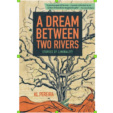KL Pereira’s captivating new collection of short fiction, A Dream Between Two Rivers, carries the subtitle “Stories of Liminality.” True to that description, many of the stories explore experiences of being on the verge—or at the edge—of a new identity, reality, or understanding. This makes for dynamic storytelling, as does the fact that the collection isn’t tied down by any one stylistic convention.
Many of the stories draw on elements of myths, folklore, or fairytales, and like those types of tales, they take us into strange, often dark situations that, however surreal, echo the emotional and psychological struggles of lived human experience.
The collection is divided into two parts: “The Loneliness” and “The Devouring.” The first part deals to a large extent with characters’ efforts to survive in, or make sense of, worlds in which they are misunderstood, ignored, or pushed to the margins. In the second part of the book, many stories deal, literally, with flesh and blood—how these are destroyed, consumed, or otherwise transformed to meet various ends, usually dark ones.
In “Not Quite Taken,” an early story in “The Loneliness” section, the main character seems trapped in an endless cycle of dying and rotting—and cursed by an awareness of this state, which is never overtaken by the peace of oblivion.
The character is also aware of having been forgotten:
Although surreal, the story movingly captures the emotions of loneliness—of feeling forgotten, unloved, or ignored.
The story “Asphodel” explores a different but no less troubling experience of the afterlife, from the point of view of the famed Penelope of Greek mythology. (A bit of background: as a baby, Penelope was cast into the sea by her father, Icarius, who had wanted a son, but she was rescued. Later, she earned praise for remaining faithful to her husband, Odysseus, who left her for twenty years to fight the Trojan War.)
Newly arrived in the afterworld, Penelope is disoriented by what she discovers there: “a department store filled with the absence of things”–and of memories. No one appears to remember anything from their earthly lives, or even from the previous moment. A potion for forgetfulness seems to flow from the fountains and through the dew of ever-present asphodel flowers, which are consumed in great quantities.
Because of these circumstances, Penelope finds herself alienated and afraid:
When Penelope has a chance to confront Icarius in the afterlife, she finds that he has forgotten that she is his daughter, that he’d tried to sacrifice her to the sea. He has replaced these memories with self-aggrandizing falsehoods, ones that exclude any meaningful connection to her.
Near the end of the story, Penelope observes, “Why do we always forget the woman, the girl? Why are they blank but for the sweet of their sex or their quick cunning?” In this passage and others, Penelope pushes back against the subjugation that she and other women faced, and her anger and frustration feel all too relevant right now.
Appearing toward the end of “The Loneliness” section of the book is one of my favorite stories in the collection, “Afterimage.” The central character, an eighteen-year-old college student, Sam, helps support herself by taking part in a crew that cleans out the homes of the dead. A budding photographer, Sam sees a connection between her job and her art:
Having grown up in the foster system, and lacking close family connections, Sam feels that “her existence is built around this absence,” and she describes herself as “unfettered.” Perhaps for those reasons, she finds herself drawn to family photographs in a house she is helping to clear.
Sam ends up taking some of the photographs back to her dorm, laying them out on her bed and reflecting on the limitations in them, and in her own experience:
I don’t want to give it away the subtly revelatory ending. But I will say that it helps make the story an especially moving and perceptive exploration of absence, and of Sam’s efforts to come to terms with it.
As I’ve noted, in many of the stories in the second part of the book, “The Devouring,” flesh and blood are destroyed, consumed, or otherwise transformed—often, for dark purposes.
One of my favorite tales from this part of the book is the title story, “A Dream Between Two Rivers,” which tells the story of a botanist who travels to South America to collect rare orchids. Back in the States, the botanist’s love of orchids, and a desire to hunt for them on the expedition,had provoked the ire of an abusive girlfriend, Justine, who “smashed [the botanist’s] rare orchids and corpse flowers over the sink in lieu of a goodbye note.”
Nonetheless, the botanist continues to dream of Justine on the orchid-hunting trip, and in those dreams finds Justine overtaken by a character out of South American folklore: a patsola. The expedition leader describes the patsola as “an angry woman” who is “fiercely protective of her jungle, especially her flowers.” He continues:
Over time, the patsola becomes more and more real to the botanist, and the descriptions of this creature make her a vivid and darkly enchanting presence for readers as well. That brings me to a larger point: throughout the collection, Pereira shows a special gift for bringing characters and settings, however fantastical, to life through telling physical details.
In the case of the title story, the writing delivers not only horror movie chills but also a perceptive exploration of how a deep desire for something—say, a rare orchid or reciprocated love—can leave us dangerously vulnerable. Reflecting on the patsola’s prey, the botanist thinks, “I wonder what it would be like to be sought after that much, even if it was to enact revenge, rather than to love.”
This story haunted me and left me with much to think about, as did so many other tales in this compelling and beautifully crafted collection.
Would My Pick be Your Pick?
If you're interested in ________, the answer may be "Yes":▪ The works of Angela Carter, Karen Russell, and Jorge Luis Borges
▪ Fairytales and/or folktales
▪ Myths
▪ Magical realism


